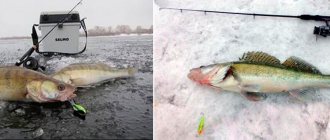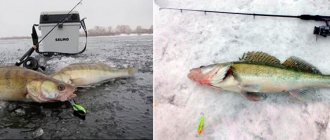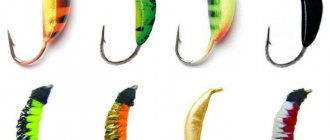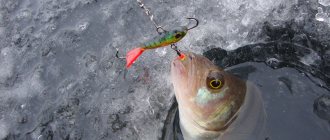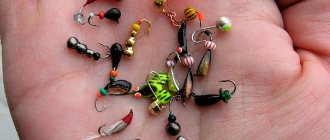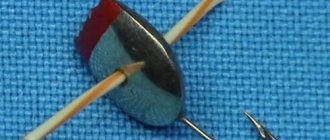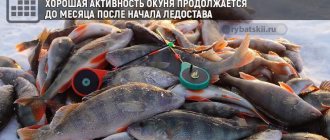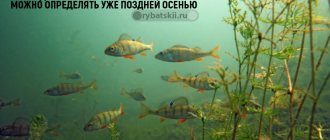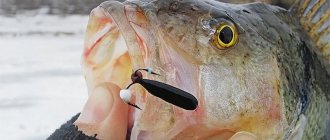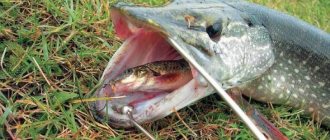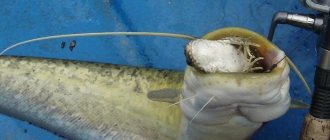Catching perch with a reelless reel in winter
During the period of first ice, perch becomes active and constantly moves around the reservoir, so you should always look for it. It will be good if you can find a place with a pitty-lumpy bottom. Moreover, it may be very far from the shore, but these are the places that large individuals prefer.
Detection of perch in a particular place depends on:
- water temperature in a given water area,
- availability of food,
- atmospheric pressure,
- degree of illumination,
- amount of oxygen in water.
In many ways, the behavior, and therefore the “walks” of the perch, depend on the water level and the presence of hydraulic structures, which dramatically affect many indicators of fish activity. Read also: The best balancers for perch
Perch is considered a light-loving fish, so it is reasonable to assume that it prefers areas with good lighting. If the perch is full, its activity decreases and no amount of bait can force it to take the bait, although in the hole you can observe the movement of the school. The most active perch bite is observed in the first way. And also the last ice, since before spawning the fish need to feed heavily. This is interesting: For perch on the first ice
Types of nozzle jigs
In terms of its design, this type of bait is practically no different from classic jigs - a weight with a hook soldered into it. But still there are some differences. For example, the shape of mothless insects usually resembles some kind of insects and bugs. The location of the jig is in most cases vertical or at a slight angle. The most common and catchy reelless jigs are:
- Ant
- Devil
- Uralka
- Nymph
- Goat
In addition to those listed above, there are many other species, but most often these are the ones that can be found in the arsenal of fishermen.
Jigs of the “Ant” type
A well-proven bait for catching perch. As a rule, it is equipped with additional colored beads or cambrics to increase the interest of the fish.
Based on the name of the jig, it becomes clear what insect it imitates. A smooth rise with slight vibrations and swaying is suitable as a game.
Devil
Lately, catching perch in winter using the devil has become popular. This type of jig is suitable for almost any wiring and game. In addition to perch, other fish also bite the devil - roach, chub, ide.
The shape of the bait resembles a dragonfly larva and has 3 hooks. For wiring, lifting a jig with a blunt jig with fast and small vibrations works well.
Catching perch with devil in winter (video):
Uralka
The shape of the bait resembles an ordinary droplet with a slight deviation of the upper part from the vertical axis. Shows its effectiveness with classic wiring with smooth rocking and oscillations. Works well during periods of low perch activity. It can also be additionally equipped with beads.
Nymph
The performance of this type of jig is selected by putting on additional cambrics. Their number changes the location of the bait in the water and, accordingly, the game. You need to play as a nymph with high-frequency vibrations with ups and downs.
In appearance and shape it is very similar to the “Uralka”. The game of the “goat” is smoother and slower, so this jig works well during the already established winter, when the perch becomes less active and it is difficult to swing it to bite. It is also equipped with different cambrics and beads to increase the effect.
Winter fishing 2019-2020! Catching perch in winter with a reelless bait. Underwater shooting. More details
CRAZY ROACH. MAD BITTING FOR THE MOTHLESS!! CATCHING ROACH WITH A JIG! More details
Mothless. Winter fishing with jigs. Cat's eye in action. More details
Winter fishing 2019-2020! Catching perch in winter with a reelless bait. Underwater shooting. More details
Reelless fishing. Equipment More details
Reelless fishing. Roach on a nailball and a devil. Winter fishing 2021. Read more
Catching roach in winter with a reelless video More details
Catching perch in winter with a jig. #Mothless [Fishing with Uncle Fyodor No. 1] More details
I PUT THIS MOTHELESS AND FUCKED! Catching roach in winter on the river 2021. Read more
Mothless 2021-Perch on a nail cube-Philosophy of a novice mothless More details
IN THE DEEP WINTER THIS TACKLE MAKES RESULTS! Catching Roach with a Reelless. WINTER FISHING 2021. Read more
MOTHLESS. FISHING WITH REPEELESS LARGE PERCH More details
WINTER FISHING WITH A MOTHELESS CHERTIK. HOW TO FISH IN WINTER Read more
Fishing in winter on Gvozdesharik! Mothless in action! Catching Perch with Mormyshka. Winter fishing 2021 Read more
Winter fishing with a reelless bait. Catching roach and perch on the river. Nailball vs Devil. More details
How to equip a reelless reel for winter fishing? More details
This is a roach on a mothless cat's eye. Catching roach in winter with a jig. More details
Lucky jig. Catching roach in winter with a reelless bait. Winter fishing 2021. Read more
We decided to visit MICRO-RIVER in winter! Fishing for roach and perch with a reelless reel! Fishing in your favorite places! More details
We always want to get results from fishing - to catch not three perch, but ten kilogram pikes - what a catch! Each of us dreams of this, but not everyone can do it.
When was the last time you caught dozens of HUGE pike/carp/bream?
We always want to get results from fishing - to catch not three perch, but ten kilogram pikes - what a catch! Each of us dreams of this, but not everyone can do it.
A good catch can be achieved (and we know this) thanks to good bait.
Tips for fisherman: How to catch bream in winter with a jig - What to choose for fishing
It can be prepared at home or bought in fishing stores. But stores are expensive, and to prepare bait at home, you need to spend a lot of time, and, to be fair, homemade bait does not always work well.
You know that disappointment when you buy bait or prepare it at home and only catch three or four bass?
So maybe it’s time to use a truly working product, the effectiveness of which has been proven both scientifically and in practice on the rivers and ponds of Russia?
Of course, it is better to try once than to hear a thousand times. Moreover, now is the season! A 50% discount on your order is a great bonus!
Despite this, catfish can be successfully caught using large spinning baits and a relatively slow retrieve. It has been noticed that baits with noise effects are very effective during this period. When the water temperature drops to 7-8 degrees, the catfish gradually begins to hibernate, showing less and less desire to take bait.
And there are those who doubt that in our rivers, which are becoming poorer every year, you can still find decent catfish in sufficient quantities. So, let's try to figure out what a real fisherman should know about the habits of catfish and what gear should be used when catching catfish.
Tackle for catfish Considering the size of the potential enemy, you should remember that when choosing gear for catching catfish, you cannot save on anything! It’s easy to imagine a situation where, despite having a rod, fishing line and hooks of the highest quality and strength, at the most inopportune moment such a small thing as a carabiner or a winding ring can fail. Therefore, you need to approach the choice of gear for catching catfish in the most serious way.
Therefore, the load must have a mass capable of resisting the windage of the fishing line and holding the bait in place. Based on this, a rod for catching catfish from the shore should have a weight of 300-500 grams, because in addition to the load, we also throw bait, which can reach a weight of 100-200 grams. The recommended rod length for fishing from the shore is 2.7-3.0 meters. Longer rods can make fishing somewhat more difficult due to the longer lever, which contributes to quick fatigue.
For spinning fishing, both from a boat and from the shore, rods with test weights of up to 150 grams are suitable. At the same time, for fishing from a boat, you can select a rod with a length of 2.4-2.7 m. casting range is not required in this case. Absolutely the same requirements apply to rods for quok fishing.
For bottom fishing from a boat, rods with weights from 200 to 350 grams are suitable.
Regardless of the fishing method, all fishing rods have one requirement - strength. In this regard, plug rods, fiberglass or composite, show themselves to be the best. It is not recommended to use telescopic fishing rods due to their low strength characteristics.
Another requirement for all fishing rods is the presence of reinforced rings. The rings must have at least three support points, and the ring inserts must be made of high-strength material (aluminum oxide, zirconium oxide, silicon carbide). Some parameters may seem too high to the inexperienced reader, but remember what kind of enemy you are fighting!
Reel The reel must be selected to match the fishing rod; it must be of high quality, powerful and must hold a large amount of fishing line. For catching catfish, multiplier reels and powerful spinning reels are best suited.
Other elements of gear In addition to all of the above, you may need various carbines, winding rings, swivels. All these elements need to be taken no less seriously than when choosing a rod or reel. Remember, in the fight against the owner of the underwater world, at the most inopportune moment, you may be let down by a low-quality or too “weak” carbine, because we are talking about serious loads on the entire tackle and on each of its individual elements.
This is what the general behavior pattern of catfish looks like, but depending on the reservoir, time of year, time of day, or weather and hydrological conditions, the habits of this predator may change.
Towards the middle or end of spring, when the water warms up to 16-18 degrees, the catfish begin their spring feeding. During this period, catfish begin to actively feed, rushing to any bait, including artificial (spinning) bait. At the same time, catfish hunt throughout the entire water area of the reservoir, both in the shallows, and on the riverbed, and at differences in depth - the edges.
If there is a flood on the river, then catfish prefer to stay near the coastal shallows, where they feed on insects and animals caught in the flood. In most cases, these are mice, worms and mole crickets. These are the best baits for catching catfish at a given time.
Catching catfish in summer When the water temperature reaches 20-23 degrees, catfish begin their spawning period, which lasts approximately 20 days. During spawning, catfish are practically not caught. After this period, the post-spawning zhor begins, which lasts from 3 to 5 days.
Tips for a fisherman: How to properly attach bloodworms to a jig in winter - Features of choice
In summer, any attachments are applicable, and it is impossible to single out any one in particular. You can catch catfish using either artificial spinning bait or live or dead fish.
Despite this, catfish can be successfully caught using large spinning baits and a relatively slow retrieve. It has been noticed that baits with noise effects are very effective during this period. When the water temperature drops to 7-8 degrees, the catfish gradually begins to hibernate, showing less and less desire to take bait.
The quok is caught from a boat, the bait is in the water column. Usually it is a frog or baitfish. The catfish, attracted by the sound of the quok, rises from the depths and attacks the bait. The equipment is almost identical to the equipment for bottom fishing from the shore. On the main line there is a sliding or “blind” weight, below, on a leash, a hook with bait.
They croak at short intervals, about 2-3 beats per minute, sometimes pausing for 1-2 minutes.
It is recommended to install the rod in special holders; placing it on the side of the boat is not recommended, because With a powerful bite, the catfish can break the rod or pull it into the water.
Catching catfish with a kwok is a fascinating activity, and an angler who has mastered fishing with a kwok will forever remain an adherent of this type of fishing.
Catfish on a float A float is another ancient tackle successfully used for catching catfish. You can catch catfish with a float both from a boat and from the shore.
From the shore, catfish can be caught using a float using a line or at one point. You need to choose a fishing spot close to holes and snags - the favorite habitats of catfish. From the usual set of baits for catfish, the best ones are bunches of worms, frogs, offal, mole crickets, that is, everything that catfish often encounters on coastal shallows.
They usually catch it on a float in the evening and at night, when the catfish leaves its shelter in search of food.
When catching catfish with a spinning rod, the usual spinning tactics are used - methodically fishing for the expected location of the catfish. An exception is the case when the catfish actively feeds at the surface of the water, which can be understood by the characteristic sounds - smacking and noisy impacts on the water. In this case, the bait is thrown into the same place.
«>
Tackle for catching perch in winter
When we go fishing for perch with a reelless reel, we sometimes hesitate: which tackle will be the most effective? On the last ice, most anglers catch perch using small spoons and a jig with a nozzle. We give preference to small baitless baits such as front sights and jigs and their combinations.
The best reelless reels for perch fishing
Traditionally good nozzle jigs are:
- "Uralka". The most universal of all jigs is the “Uralka”, with a yellow, white, orange or red bead on the hook. To achieve success in deep and shallow water fishing, you need to use a thin fishing line with a diameter of no more than 0.12 mm, or better yet, a diameter of 0.06-0.08, have a properly made nod and a fishing rod that is convenient for active play.
- “pellet” A tungsten “pellet” with a white or black bead is considered an all-season bait. In some cases, a lead “pellet” with a black or brown bead on the line and a piece of red or orange sponge on the hook works well. Other times, a combination of white and red or red and black beads provides a stable bite. Free play of the beads is required - it creates an additional noise-attracting effect.
- "ant". When catching perch with an ant, first of all use a bronze color with bright colored eyes on the sides, as well as jigs with brass or copper soldering on the sides. As for the size of the “ant”, in most cases I prefer to use baits of the minimum size for the given conditions. That is, for fishing at a depth of up to 1.5 m I always use the smallest available size; at greater depths I also try to use “ants” of the same size. And only when fishing in the current at a depth of more than 4 m, sometimes I use medium-sized “ants”.
- “ovinka”, Much more important when choosing a jig is its weight, diameter, and also the hook. It is the latter, in case of poor compatibility with fishing conditions and, especially, poor quality, that can cancel out many efforts. A hook usually has two problems - it is dull and small. Fortunately, this is somewhat easier in modern jigs, but many old lead jigs have simply terrible hooks. One piece of advice might be to avoid buying the cheapest lead jigs, or to keep an eye out when purchasing them.
- "droplet" They sway better when the winter fishing rod moves. Jigs - droplets are used for reelless fishing of perch with an inclined suspension. They also attract fish when they move on the bottom.
As for color, preference should be given to:
- black,
- purple,
- brown,
- green,
- reddish baits.
On the shank of the hook you can plant a grain from:
- white,
- yellow,
- red
- black rubber.
In more turbid water, it is advisable to change the rubber to white dense foam rubber or yellow beads.
Tungsten jigs are good because they are heavier, which means they are easier to get to the bottom. A tungsten jig has a good effect on the nod game, and it is more often used when fishing at great depths, since it is quite small with a large weight. On the last ice, perch most often prefers a tungsten “drop” of black or red color with a diameter of 2.5–3.5 mm. Perch is well attracted to jigs with a red and black pattern in the shape of a fish eye.
Very often, anglers catch perch using a baitless “devil,” but not everyone knows that sometimes you can increase the catchability of the gear by adding a tiny jig or fly to the line above the main bait.
The fly can be made by wrapping a size 18-22 hook with a long shank with red silk thread. Sometimes black and white threads are attractive to perch. A nymph can also be used as a second bait.
One of its variants is made like this. A gray bead is put on hook No. 18 - it will imitate the head of an insect; then a piece of polyethylene is placed on the fore-end and a thin copper wire is wound around it - this will be the body. The polyethylene should be straightened and a forked tail should be cut out of it (picture on the left). Such a nymph has gliding movements, which perch really like. “Devil” and “nymph” complement each other, and two perches can bite on them at the same time. The beads placed on the shank of the hook themselves create characteristic vibrations that attract the attention of the fish.
Another category of baitless baits that attract perch are flat jigs. The best performance is achieved by a flat, elongated jig in the form of a slightly bent oval. The weight of the jig can be increased or decreased by changing the thickness of the plate from which it is made. The materials used are brass, bronze, silver, and tungsten.
Fishing technique
Wiring a reelless baitfish can have many options, each of which will be effective under certain conditions, bringing a bite as a result of its use.
That is why the fisherman needs to experiment with wiring more often until he selects the optimal option for certain fishing conditions. There are quite simple, but at the same time effective techniques for wiring a rewinder. The first wiring is classic - with frequent active oscillations and small amplitude. In certain groups of anglers it is called "dribbling" or "shaking". With this wiring you should start fishing the hole at the stage of searching for perch. At the end of the retrieve, it is recommended to pause for five seconds, holding the nozzle-less jig at the top point.
The second basic retrieve involves a smooth lift and swinging of the rod with a large amplitude and low frequency. This type of wiring is well suited for catching passive perch. It is also effective when fishing on the last ice.
These two wires in most cases help to detect perch.
The procedure is extremely simple:
- a hole should be drilled;
- make two lifts of the rewinder with great frequency, maintaining the above-mentioned pause at the top point at the end of the second lift;
- while swinging the rewinder, perform several lifts;
If there is no effect, then you can try to repeat the cycle again or immediately move to another hole. There may be cases when the perch does not react to these postings or at first shows activity, and then calms down. In such cases, it would be advisable to use other wiring.
Active, frequent play with pauses may be helpful. This concept means a classic fast game. After immersing the jig to a depth, you need to raise it by 5-7 cm, then pause for 3-5 seconds, then lift it again and hold for the specified time. The cycle must be repeated until the rewinder is at the top point. You can do it a little differently: lift the nozzle jig smoothly, occasionally stopping it.
After such wiring, you can make the wiring by swinging in the form of a dotted line. This method sometimes turns out to be useful in the process of luring passive perch.
There is a relatively simple wiring - lifting the rewinder slowly and evenly. The only difficulty is that it requires concentration. The lifting speed should be low and the lift should be smooth without hesitation.
In some cases, in order to attract perch, it is necessary to carry out active wiring with minimal fluctuations at a certain point. The method is used when it is necessary to attract inactive perch or to concentrate fish in the area of the hole when it is dispersed within a certain reach radius.
If all the wiring has been tried, but there is no success, then you should try the same wiring, but in reverse order - from top to bottom. This may take effect during periods of changing weather conditions or during the last ice break.
There are a lot of options for playing with a jig. Each wiring can be effective. It all depends on the specific conditions in which the fisherman finds himself. Only experimentation and improvisation will help you achieve success. It is likely that the fish will be attracted by unusual wiring, invented by the fisherman himself during the fishing process.
Bait when catching perch in winter using a reelless bait
Despite the fact that fishing is carried out without bait, bait is another success factor. However, it is necessary to feed the place when the bite is weak or completely absent. It happens that with the addition of bloodworms to the hole, the perch’s bite on the bloodless one stops completely. In this case, you need to change the place. But sometimes adding bloodworms to the hole, thrown in pinches from above, provokes the perch to grab a baitless jig.
In winter, bloodworms, maggots, and chopped dung worms harvested in the fall are used as bait.
Catching perch in winter with a reelless video
An underwater camera records how a perch reacts to a mothless ant with a yellow bead. Filmed in the middle of nowhere. depth 1.20 cm.
Catching perch with a reelless video . The fishing technique that day was slightly changed to a more delicate one. Having drawn conclusions from my previous fishing, I decided to catch perch using a reelless reel, but the search is still carried out using a balancer. A few words about the tackle, an ordinary balalaika with 30 m of Sunline Siglon fishing line with a diameter of 0.1 and 1 kg for breaking. Tungsten jig Shark Ant. I decided to add bright beads to the main line above the jig; this, in my opinion, certainly played a role in fishing. The fact is that when playing with a jig, the beads hit each other freely along the fishing line, but to achieve the best effect, you need to shorten the length of the nod to a minimum, that is, make it as rigid as possible. A dozen holes are cut, the search for perch begins with a balance beam, the first poke in the hand, hook and the first one goes... I immediately lower the balancer to concentrate the flock under the hole and make sure that this is not the only specimen, tossing, hooking... Jig, your time has come
